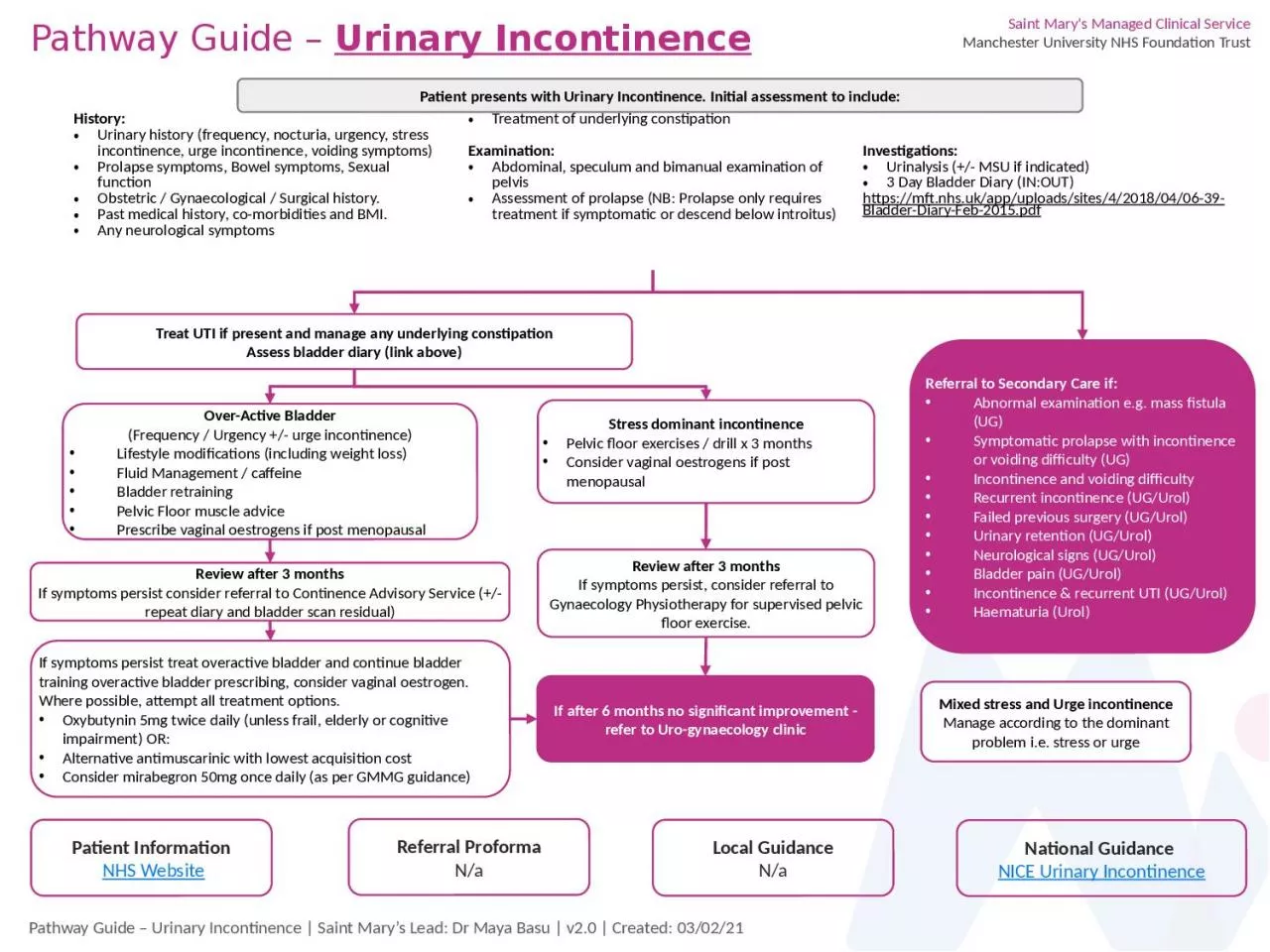

History Urinary history frequency nocturia urgency stress incontinence urge incontinence voiding symptoms Prolapse symptoms Bowel symptoms Sexual function Obstetric Gynaecological Surgical history ID: 1000647
Download Presentation The PPT/PDF document "Pathway Guide – Urinary Incontinence" is the property of its rightful owner. Permission is granted to download and print the materials on this web site for personal, non-commercial use only, and to display it on your personal computer provided you do not modify the materials and that you retain all copyright notices contained in the materials. By downloading content from our website, you accept the terms of this agreement.
1. Pathway Guide – Urinary IncontinenceHistory: Urinary history (frequency, nocturia, urgency, stress incontinence, urge incontinence, voiding symptoms)Prolapse symptoms, Bowel symptoms, Sexual functionObstetric / Gynaecological / Surgical history.Past medical history, co-morbidities and BMI.Any neurological symptomsTreatment of underlying constipationExamination:Abdominal, speculum and bimanual examination of pelvisAssessment of prolapse (NB: Prolapse only requires treatment if symptomatic or descend below introitus)Investigations:Urinalysis (+/- MSU if indicated)3 Day Bladder Diary (IN:OUT)https://mft.nhs.uk/app/uploads/sites/4/2018/04/06-39-Bladder-Diary-Feb-2015.pdf Patient presents with Urinary Incontinence. Initial assessment to include:Pathway Guide – Urinary Incontinence | Saint Mary’s Lead: Dr Maya Basu | v2.0 | Created: 03/02/21National Guidance NICE Urinary IncontinencePatient Information NHS WebsiteReferral ProformaN/aLocal GuidanceN/aReferral to Secondary Care if:Abnormal examination e.g. mass fistula (UG)Symptomatic prolapse with incontinence or voiding difficulty (UG)Incontinence and voiding difficultyRecurrent incontinence (UG/Urol)Failed previous surgery (UG/Urol)Urinary retention (UG/Urol)Neurological signs (UG/Urol)Bladder pain (UG/Urol)Incontinence & recurrent UTI (UG/Urol)Haematuria (Urol)Treat UTI if present and manage any underlying constipationAssess bladder diary (link above)Over-Active Bladder(Frequency / Urgency +/- urge incontinence)Lifestyle modifications (including weight loss)Fluid Management / caffeineBladder retrainingPelvic Floor muscle advicePrescribe vaginal oestrogens if post menopausalStress dominant incontinencePelvic floor exercises / drill x 3 monthsConsider vaginal oestrogens if post menopausalReview after 3 monthsIf symptoms persist consider referral to Continence Advisory Service (+/- repeat diary and bladder scan residual)Review after 3 monthsIf symptoms persist, consider referral to Gynaecology Physiotherapy for supervised pelvic floor exercise.If symptoms persist treat overactive bladder and continue bladder training overactive bladder prescribing, consider vaginal oestrogen. Where possible, attempt all treatment options.Oxybutynin 5mg twice daily (unless frail, elderly or cognitive impairment) OR:Alternative antimuscarinic with lowest acquisition costConsider mirabegron 50mg once daily (as per GMMG guidance)If after 6 months no significant improvement - refer to Uro-gynaecology clinicMixed stress and Urge incontinenceManage according to the dominant problem i.e. stress or urge